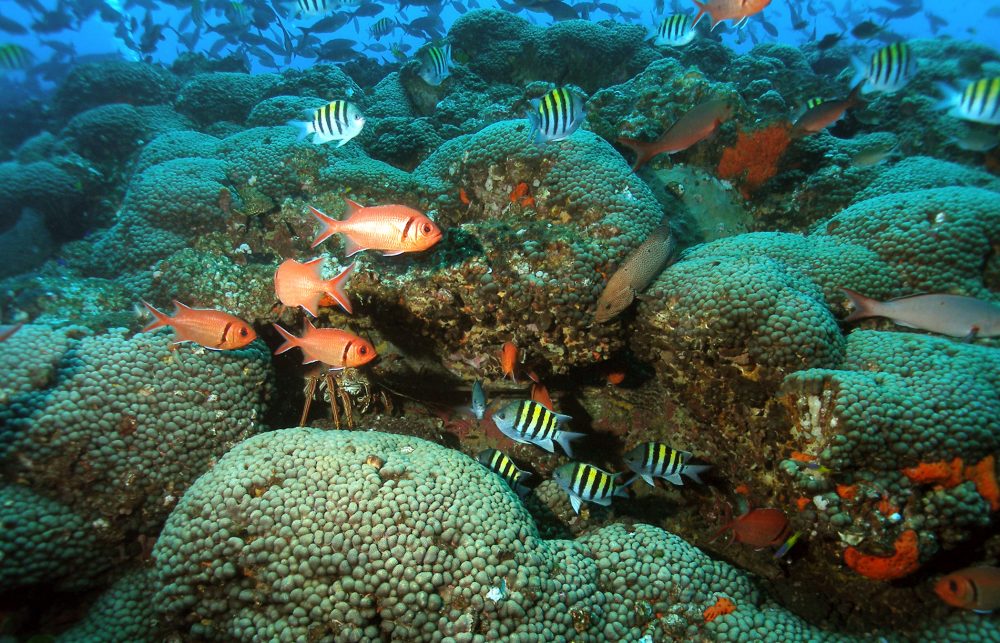
A coral reef 100 miles off the Texas Gulf Coast is doing better than others that are facing the fourth global coral bleaching event.
According to the National Oceanic and Atmospheric Administration (NOAA), coral bleaching happens when corals are stressed by changes in conditions like temperature, light, or nutrients; bleached coral is more susceptible to disease.
The depth of the Flower Garden Banks Marine Sanctuary in the Gulf of Mexico has helped the reef avoid the extreme bleaching present in other areas in the nation. The reef is almost 60 feet deep in the shallowest parts of the reef. By comparison, reefs like the Florida Keys can be as shallow as five feet in some areas.
Michelle Johnston is the Sanctuary Superintendent for the Flower Garden Banks. She said shallow reefs have a harder time with rising ocean temperatures.
“That’s not to say that we don’t get bleaching,” she said. “We do, and we had a moderate amount of bleaching last summer, but nowhere near the extent of what was seen in the Florida Keys.”
Coral bleaching was first observed in the 1980s. The NOAA has recorded and monitored significant damage to coral reefs since 2000 through the Coral Reef Watch, which then records global coral bleaching events. A coral bleaching event from 2014 to 2017 is now considered the longest, most widespread and damaging event on record.
Johnston said some researchers are looking into light therapy and ways to artificially cool down water near the reefs, like bringing in a hose to manually pump cooler water near the reefs.
“Some ideas that maybe 10 years ago seemed crazy don’t seem so crazy anymore,” she said.
Aquariums like Moody Gardens are working to help coral reefs keep up with climate change. Johnston said some corals are more resistant to heat than others, and the coral lab at Moody Gardens has a small sample size of corals to study.
According to the Great Barrier Reef Foundation, El Niño can increase the risk of coral bleaching. El Niño usually brings warmer, drier summers. Hurricanes, on the other hand, can sometimes bring benefits to reefs.
Two-thirds of the U.S., all of Eastern Mexico, and a small part of Canada’s watershed flows into the Gulf of Mexico. The Mississippi River Basin alone accounts for the largest portion, according to the NOAA. Kelly Drinnen, the Acting Education Coordinator for the Flower Garden Banks, said this can bring muddy water to the gulf.
“We have seen very large storms like hurricanes that hit the Texas-Louisiana coastlines that muddy water that contains who knows what,” she said. “… even if it’s not sediments in the waters and possible pollutants, the freshwater influx changes things that are offshore every once in a while.”
However, Drinnen said some storms like Hurricane Rita have actually prevented bleaching events. Michelle Johnston said smaller tropical storms can serve as a way for the ocean to clean itself.
“I was told once that hurricanes are kind of like nature’s way of air conditioning, you know, it churns stuff up and cools it down,” she said.
The NOAA recommends traditional environmental efforts like reducing water and electricity usage, recycling, and disposing of trash responsibly to support aquatic ecosystems. Michelle Johnston said activism, going to scuba events, and visiting local aquariums can also go a long way.
“This place really is a national treasure. It is a safe haven for wild corals,” she said. “… The fact that we have such a healthy ecosystem, and a place where corals are still thriving, and fish communities are thriving, is something that’s rare in this day and age.”

 91 °F
91 °F